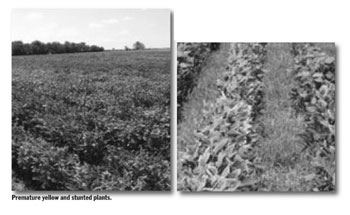Stunted Soybean Fields May Be Due To Planting Or Working Fields When Wet
SPRINGFIELD, MO.
Southwest Missouri fields were dry on Aug. 31 when Jay Chism, agronomy specialist with University of Missouri Extension, scouted the for his weekly report. That is no longer the case for many area fields. But even with the lack of moisture prior to Aug. 31, Chism said most of the soybean fields were still looking good overall.
“Soybeans on thinner soils or late planted beans are showing the most drought stress,” said Chism.
He did visit one field that was very stunted and beginning to yellow prematurely. “This field actually had multiple issues. Although this is the first field I have seen this season showing yellow, stunted plants these symptoms have been very common during the two previous seasons,” said Chism.

Symptoms occur when fields are planted or worked too wet. This leads to compaction and a limited root system. “The plants have been sent to the diagnostic lab for confirmation, but I think the results will show potassium deficiency as well as early signs of Cercospora blight,” said Chism.
The limited root system is not able to pull in the needed nutrients causing a stunted plant. Cercospora blight, can affect all parts of the plant, but is best known for discoloration of the seed, purple seed stain.
Soybean pod worms and spider mites were also present in this planting. “I would not recommend an insecticide or a fungicide on fields with these types of symptoms. The yield potential of this field is limited and probably does not justify treatment,” said Chism. “Rainfall might also help by allowing the root system to expand further in the soil.” Δ